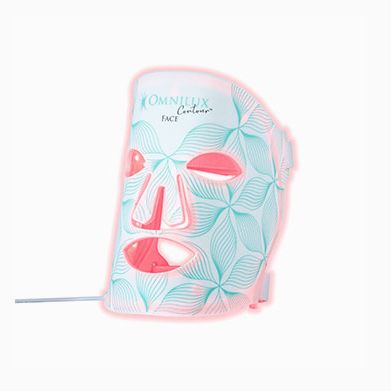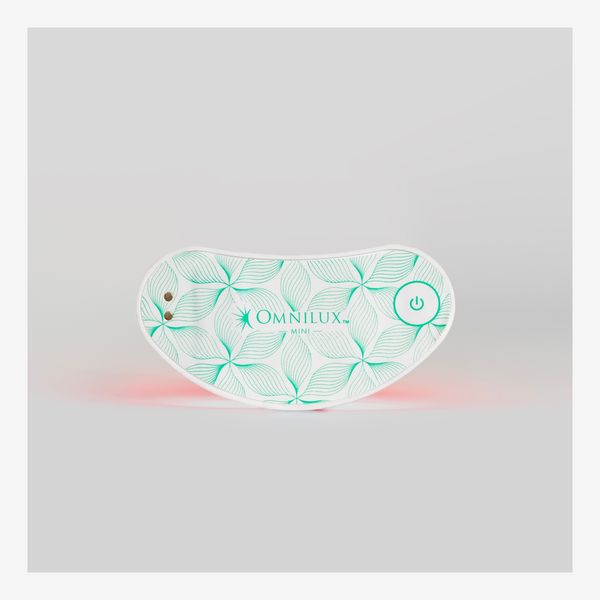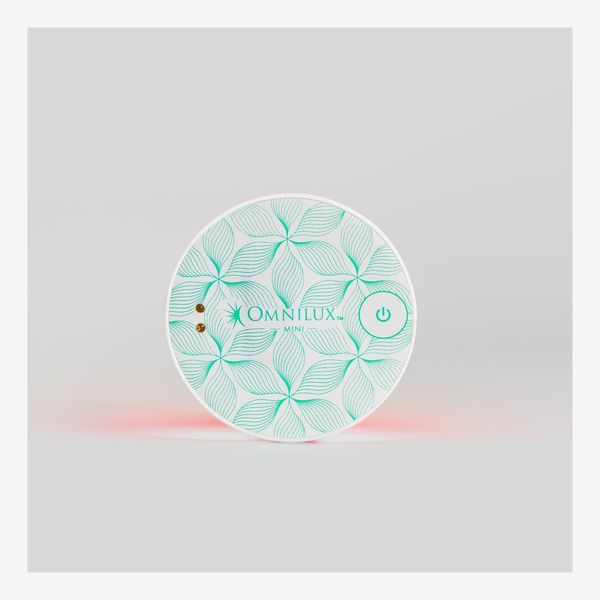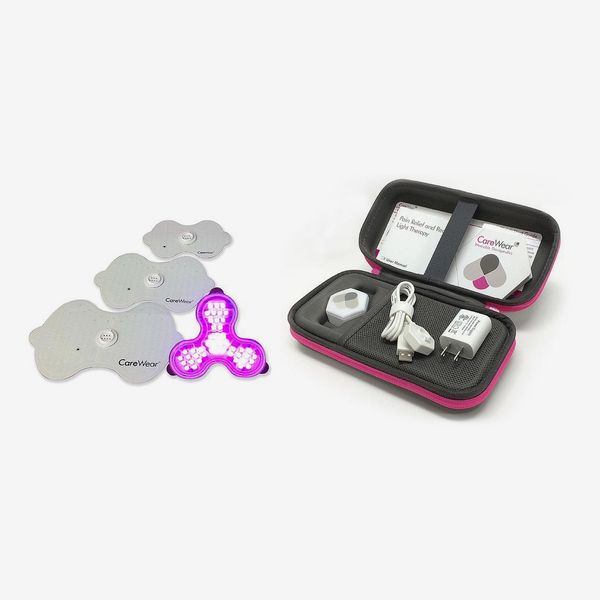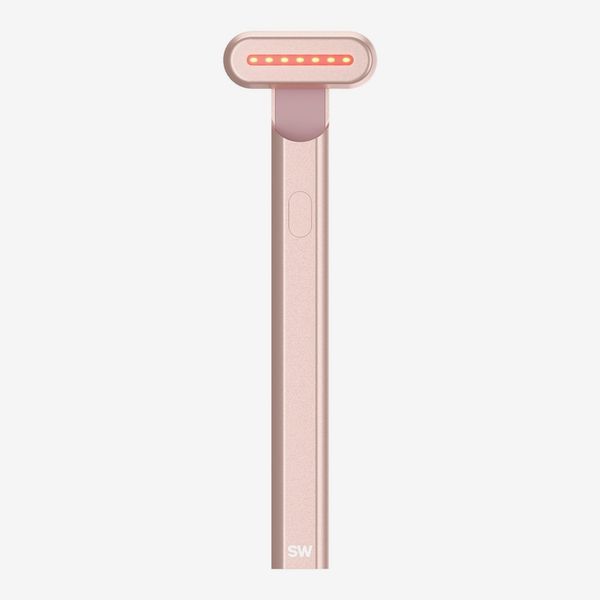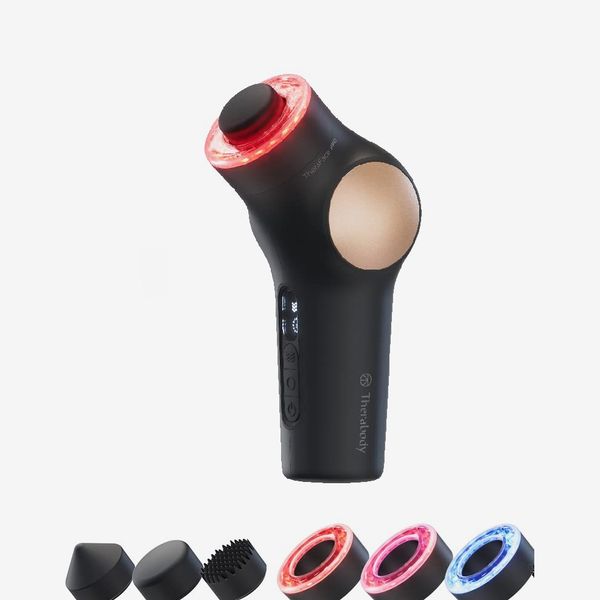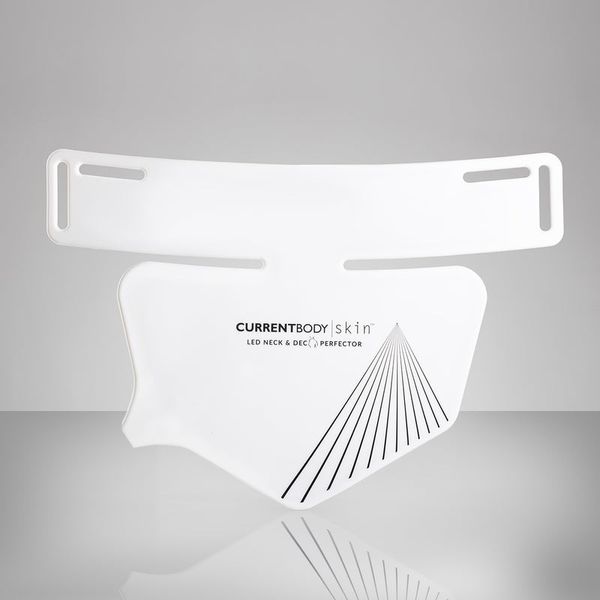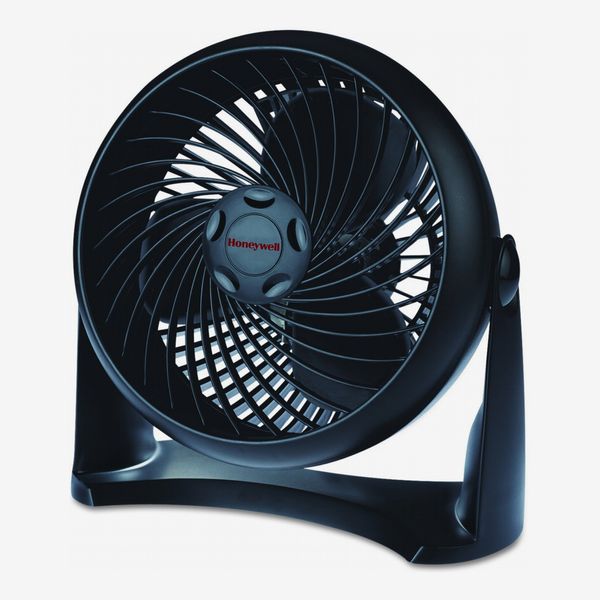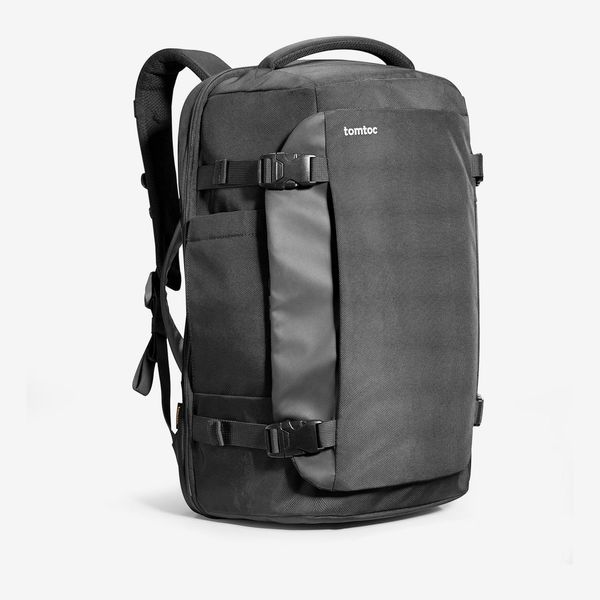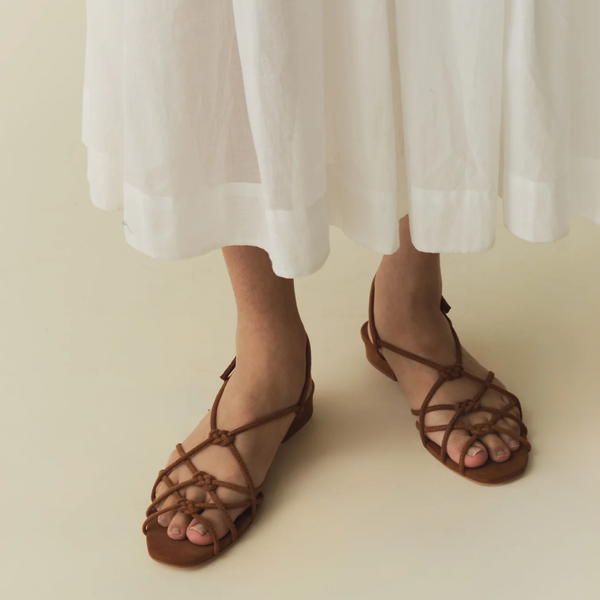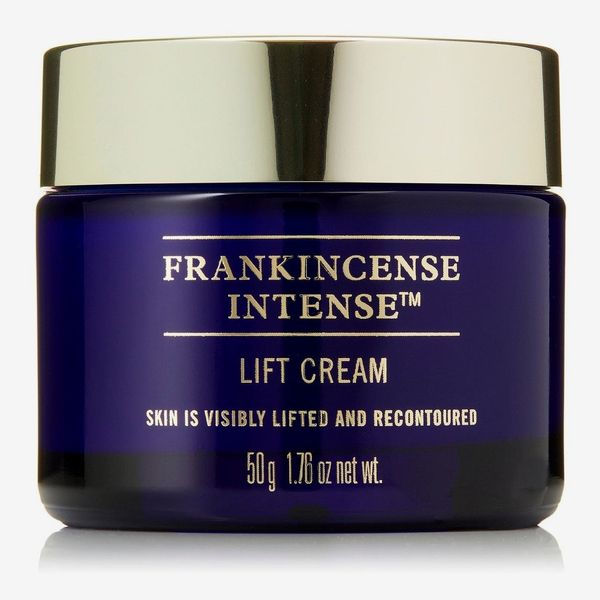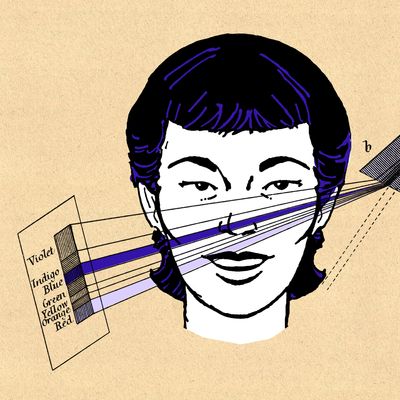
If you’ve spent even five minutes on the beauty side of TikTok, you’ve undoubtedly come across an influencer wearing a Darth Vader–style mask with light emanating from its perimeters or waving a glowing wand over their face. Light therapy via at-home LED (light-emitting diodes) devices is trending in skin care right now, but it’s not just a fad. According to Dr. Jared Jagdeo, who is the director of the Center for Photomedicine at SUNY Downstate Medical Center and a leading researcher on the subject, LED-light therapy has been around for about two decades.
LED-light therapy harnesses different wavelengths of light to trigger chemical reactions that increase energy production inside cells, reduce cellular damage, promote healthier cell functioning, and stimulate collagen production. It also improves blood circulation and encourages the formation of new blood vessels, all of which translates to major skin benefits.
You can try LED-light therapy in many different colors, each one suited to a different purpose. Red light and blue light are, by far, the most popular choices — and for good reason: “Red light and blue light have been extensively studied and have clinical studies showing effects for various skin concerns,” says Dr. Danilo C. Del Campo, a dermatologist at the Chicago Skin Clinic. “The studies date back decades and have been expanding in their uses ever since.”
We talked to experts and scoured the research to answer your questions about both forms of light therapy so that you can pick a high-quality device and use the color setting that works best for you. That said, it’s still important to consult your dermatologist before incorporating LED-light therapy into your skin-care routine. “As a dermatologist, I don’t have any qualms per se about the consumer using some of these devices that are FDA-approved, but it should be part of a treatment plan,” says Dr. Monica K. Li, who has performed several studies on light therapy for acne.
What is blue-light therapy?
Blue-light therapy, which uses wavelengths between 380 to 500 nanometers, targets bacteria and infections on the skin’s surface. The FDA approved blue-light therapy for the treatment of acne in 2002, and that continues to be the primary reason it’s used.
Li says blue light can effectively reduce acne-forming bacteria, which will prevent and reduce the severity of breakouts. (You may need to combine blue-light therapy with other treatments to effectively clear more severe forms of acne, such as nodules and cysts.)
In addition to treating acne, Del Campo says blue light can improve skin clarity, regulate oil production, and potentially help with conditions like sun damage and rosacea. It can also be useful for treating eczema and itching, as well as stimulating hair growth, according to a study out of the Medical University of Łódź in Poland. And other research suggests that LED blue-light therapy improves symptoms of psoriasis.
However, several of the dermatologists we’ve spoken with say that the evidence supporting blue-light therapy for use outside of acne treatment is not as robust as it should be, so take it with a grain of salt. “The original FDA approval for blue-light therapy was done in the early 2000s, and it only got approval for treating acne,” explains Del Campo. Blue lights are also more expensive than the red ones. For both of those reasons, you’re unlikely to find blue-light-only devices. Instead, you’ll see devices that combine blue and red light or devices that allow you to toggle between different colors.
What is red-light therapy?
Compared to blue light, red-light therapy uses longer wavelengths of light, between 630 and 940 nanometers, which allows it to penetrate deeper than the top layer of skin. As explained by the Cleveland Clinic, red light can boost cellular energy, reduce inflammatory proteins, stimulate collagen production, and increase blood circulation. These effects make red light quite popular for treating signs of aging. They also make it useful in wound-healing and managing inflammatory skin conditions like rosacea, inflammatory acne, psoriasis, and eczema.
Del Campo says that red-light therapy can be a good option for people who want an anti-aging treatment that won’t interfere with their pregnancy journey. “I get a lot of patients who are trying to become pregnant, and they don’t want to be on any prescriptions that can be a risk to a baby, so that takes away a lot of anti-aging retinoids and a lot of other topicals that we would often use,” he explains.
Is there any benefit to using blue and red light together?
Yes! Because red- and blue-light therapy solve somewhat different issues, they complement each other when combined. “Using both therapies together can result in clearer, healthier, and more youthful-looking skin,” says Del Campo.
Dr. Terrance Baker, who is the president of the North American Association for Photobiomodulation Therapy, also notes that a combination can be useful if your medical condition involves both infection and inflammation. A painful cystic pimple among a larger acne breakout is a prime example; blue light’s antibacterial properties will target and kill the bacteria on the skin’s surface, while red light can help reduce inflammation and promote healing of the infected area. “There have been several scientific studies demonstrating that the combination of red and blue light is more effective than topical benzoyl-peroxide cream” for treating acne, says Li.
Are there any risks to using blue or red LED-light therapy?
Baker notes that side effects from light-therapy devices are rare but can occur if patients are sensitive to light, use the device improperly, or if the device malfunctions. He advises immediately stopping treatment and consulting a doctor if you experience any pain or swelling.
Certain medical conditions such as melasma, iron-metabolism deficiencies, and autoimmune disorders can increase sensitivity to ultraviolet light, potentially causing rashes or generalized redness after brief sun exposure. Additionally, some medications — including certain blood-pressure medications and antibiotics — along with skin-care products like tretinoin or glycolic acid can heighten sensitivity to ultraviolet light. Therefore, consulting a doctor before using these devices is essential.
Proper use is crucial to avoid complications, so it’s imperative that you follow the manufacturer’s instructions carefully and make sure your device is legit. One of Del Campo’s patients sustained severe burns after using an unbranded device purchased from a drop-shipper.
Jagdeo acknowledges that while light therapy is generally low risk, there are potential adverse effects, including hyperpigmentation and blisters. He also notes that research suggests people of color may be more sensitive to visible light, recommending an every-other-day treatment frequency instead of daily use to mitigate risks.
How do at-home LED-light devices compare to in-office LED-light-therapy treatment?
For safety reasons, at-home LED-light-therapy devices are much less powerful than those that dermatologists use in their offices. Because of that limited potency, at-home devices have to be used for an extended period to deliver results. Patients who receive in-office treatment can expect to see a difference in their skin in a handful of sessions.
What are the best at-home light-therapy devices?
Owing to safety concerns, it’s crucial to do research before making a purchase. Jagdeo recommends buying devices “that have been studied through the scientific peer-review process” to ensure they’ve been evaluated by independent experts for effectiveness, safety, and reliability.
Few brands have gone through the peer-review process, so Del Campo also recommends looking at well-known brands with American-based customer service and FDA clearance.
After you’ve checked those boxes, you should consider which style of device is best. For targeting individual blemishes or localized pain, spot-treatment devices like wands, flashlight-shaped devices, or stickers are ideal. For more comprehensive anti-aging treatments covering larger areas, masks are more appropriate. Additionally, while some devices are straightforward with a simple on-off operation, others offer adjustable light settings, allowing users to tailor their treatments even further. Regardless of what you end up purchasing, manufacturers typically recommend brief treatment sessions — ranging from five to 15 minutes — several times a week.
Here, some recommendations from the dermatologists we interviewed:
Best red-light device for anti-aging treatment
Jagdeo, who has consulted for Omnilux, often recommends its products because they’re the only devices he knows of that have gone through the peer-review process (its use appears in more than 40 peer-reviewed clinical papers and studies).
The Omnilux Contour Face uses red and infrared light to make your skin look younger and healthier, reducing signs of fine lines, wrinkles, pigmentation, and redness. It’s a flexible silicone mask that you strap to your head so that it comfortably sits in place for the full ten-minute treatment session.
Omnilux recommends repeating this treatment three to five times per week for four to six weeks. Paris Hilton told the Strategist she uses it “three times a week. If I’m on business calls where I’m not on-camera, I’ll be lying there with it.” According to a brand representative, users tend to see a reduction of fine lines and wrinkles within that time period. After that, the brand recommends using the device at least three times per week for maintenance.
Best red-light device for under eyes
The Eye Brightener device is shaped like an under-eye mask to specifically target dark circles and fine lines in that region. Not only does it emit red and near-infrared wavelengths to stimulate collagen and elastin production and reduce inflammation and pigmentation, but it comes with patches infused with ingredients like niacinamide (which brightens dark circles) and amino-acid-rich peptides (which firm and hydrate skin).
Similar to the Omnilux Contour Face device, the Eye Brightener is intended to be used for ten minutes three to five times per week for four to six weeks.
Best red-and-blue-light device for treating acne
Around the size of a hockey puck, the Omnilux Mini Blemish Eraser is big enough to treat a cluster of acne rather than a single pimple. It combines red, infrared, and blue light so that it eliminates bacteria and reduces inflammation and redness.
Like the Eye Brightener, the Blemish Eraser comes with hydrocolloid patches infused with salicylic acid and green tea to adhere the device to your skin and treat it with a topical solution. Although the initial treatment is the same as the other Omnilux devices (four ten-minute sessions per week for four to six weeks), the brand does not recommend a maintenance period. Instead, stop treating the area after six weeks.
Best interchangeable device for spot treatment
Baker appreciates the AAH Light for its durability and portability. Unlike the Omnilux Contour Face mask, which treats the face in its entirety, this flashlight-shaped device is useful for spot treatment. Baker uses the AAH Light to tamp down hair growth, facial acne, sore muscles, tendinitis, and more. The AAH Light comes with red-, blue-, and green-light heads, so you can select the light types that best suit your needs.
To use it, simply hold or hover the AAH Light over the area you’re treating, keeping it steady for ten to 30 seconds. Then move it about an inch over and hold again. Repeat this until you’ve covered the whole area you’re working on.
Although it isn’t FDA-approved, Baker appreciates its small size, airplane-grade aluminum, and the fact that it’s waterproof. “I’ve got units that I’ve used every day for five years, and they’re still working,” he says.
Best red-and-blue-light device for injury recovery and pain relief
Baker also likes CareWear, which claims to be the first wearable, wireless, FDA-registered LED-light patch. “CareWear puts together a wonderful unit because it’s basically a Band-Aid of light,” says Baker. You simply peel the cover off the reusable adhesive patch, apply it to the area you want to treat, attach the controller, and click the controller’s button to turn it on.
Combining red and blue light, the patches are designed for injury recovery and pain relief rather than for dermatological use. They are rechargeable, reusable, and waterproof.
Other LED devices we’ve written about
Our Experts
Dr. Jared Jagdeo, director of the Center for Photomedicine at SUNY Downstate Medical Center
Dr. Monica K. Li, dermatologist at Vancouver Skin MD
Dr. Terrance Baker, president of the North American Association for Photobiomodulation Therapy
Dr. Danilo C. Del Campo, dermatologist at Chicago Skin Clinic
The Strategist is designed to surface the most useful, expert recommendations for things to buy across the vast e-commerce landscape. Some of our latest conquests include the best acne treatments, rolling luggage, pillows for side sleepers, natural anxiety remedies, and bath towels. We update links when possible, but note that deals can expire and all prices are subject to change.
